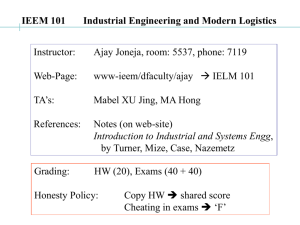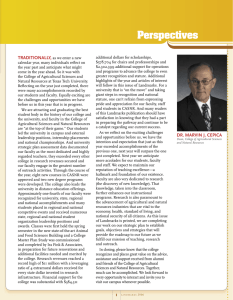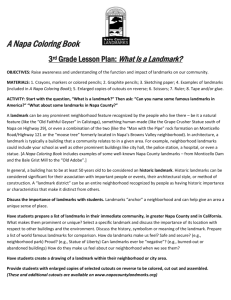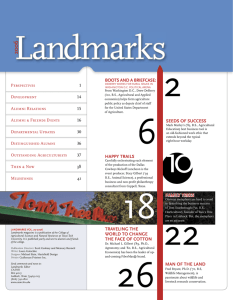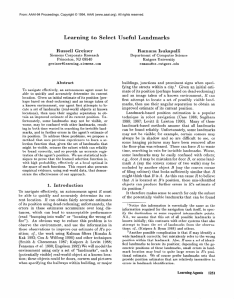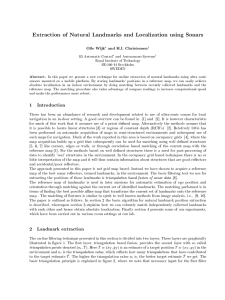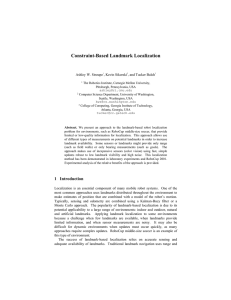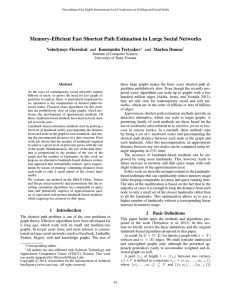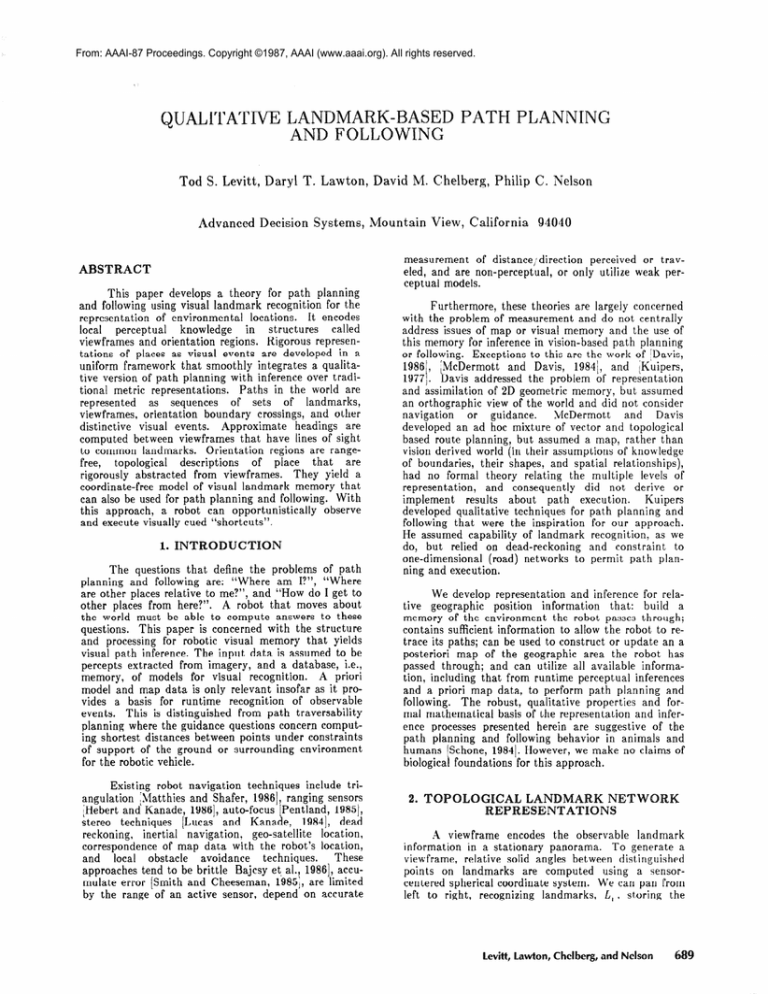
From: AAAI-87 Proceedings. Copyright ©1987, AAAI (www.aaai.org). All rights reserved.
QUALITATIVE
”
Tod S. Levitt,
Advanced
LANDMARK-BASED
AND FOLLOWING
Daryl
‘I’. Lawton,
David M. Chelberg,
Decision Systems, Mountain
ABSTRACT
This paper develops a theory for path planning
and following using visual landmark recognition for the
representation of environmental
locations. It encodes
local perceptual
knowledge
in structures
called
viewframes and orientation regions. Rigorous representations of places as visual events are developed in a
uniform framework that smoothly integrates a qualitative version of path planning with inference over traditional metric representations.
Paths in the world are
represented as sequences of sets of landmarks,
viewframes, orientation boundary crossings, and other
distinctive visual events. Approximate
headings are
computed between viewframes that have lines of sight
to common landmarks. Orientation regions are rangeof place that
are
free, topological
descriptions
rigorously abstracted from viewframes.
They yield a
coordinate-free model of visual landmark memory that
can also be used for path planning and following. With
this approach, a robot can opportunistically
observe
and execute visually cued “shortcuts”.
1. INTRODUCTION
The questions that define the problems of path
planning and following are: ‘<Where am I?“, “Where
are other places relative to me?“, and ‘LH~~ do I get to
other places from here?“. A robot that moves about
the world must be able to compute answers to these
questions. This paper is concerned with the structure
and processing for robotic visual memory that yields
visual path inference. The input data is assumed to be
percepts extracted from imagery, and a database, i.e.,
A priori
memory, of models for visual recognition.
model and map data is only relevant insofar as it provides a basis for runtime recognition of observable
events. This is distinguished from path traversability
planning where the guidance questions concern computing shortest distances between points under constraints
of support of the ground or surrounding environment
for the robotic vehicle.
Existing robot navigation techniques include triangulation [hfatthies and Shafer, 19861, ranging sensors
[Hebert and Kanade, 19861, auto-focus [Pentland, 19853,
stereo techniques [Lucas and Kanade, 19841, dead
geo-satellite location,
reckoning, inertial navigation,
correspondence of map data with the robot’s location,
These
and local obstacle avoidance
techniques.
approaches tend to be brittle Bajcsy et, al., 19861, accumulate error [Smith and Cheeseman, 19851, are limited
by the range of an active sensor, depend on accurate
PAT
PLANNING
Philip
View, California
C. Eelson
94040
measurement of distance/direction
perceived or traveled, and are non- perceptual, or only utilize weak perceptual models.
Furthermore, these theories are largely concerned
with the problem of measurement and do not centrally
address issues of man or visual memory and the use of
this memory for inference in vision-based path planning
or following. Exceptions to this are the work of IDavis,
19861, ;McDermott
and Davis, 1984], and [Kuipers,
19771. Davis addressed the nroblem of renresentation
and assimilation of 2D geomeiric memory, but assumed
an orthographic
view of the world and did not consider
- _
navigation
or guidance.
McDermott
and Davis
developed an ad hoc mixture of vector and topological
based route planning, but assumed a map, rather than
vision derived world fin their assumptions of knowledge
of boundaries, their ‘shapes, and spatial relationship;),
had no formal theory relating the multiple levels of
representation,
and consequently did not derive or
Kuipers
implement
results about - path- execution.
developed qualitative techniques for path planning and
following that were the inspiration for our approach.
He assumed capability of landmark recognition, as we
do, but relied on dead-reckoning and constraint to
one-dimensional (road) networks to permit path planning and execution.
We develon renresentation and inference for relative geographic- position information
that: build a
memory of the environment the robot passes through;
contains sufficient information to allow the robot to retrace its paths; can be used to construct or update an a
posterior; map of the geographic area the -robot has
passed through; and can utilize all available information, including that from runtime perceptual inferences
and a priori map data, to perform path planning and
following.
The robust, qualitative properties and formal mathematical basis of the representation and inference processes presented herein are suggestive of the
path planning and following behavior in animals and
humans [Schone, 19841. However, we make no claims of
biological foundations for this approach.
2. TOPOLOGICAL
LANDMARK
REPRESENTATIONS
NETWO
.A viewframe encodes the observable landmark
information in a stationary panorama. To generate a
viewframe, relative solid angles between distinguished
points on landmarks are computed using a sensorcentered spherical coordinate system. We can pan from
left to right, recognizing landmarks, L, . storing the
Levitt, bawton, Ckelberg, and Nelson
689
A natural environmental representation based on
viewframes orientation
regions and LPB crossings,
recorded while following a path, is given by a list of the
ordered sequence of viewframes collected on the path,
and another list of the set of landmarks observed on
the path. For efficiency, the landmark list can be
formed as a database that can be accessed based on
spatial and/or visual proximity.
When a new viewpath is added to the database of
additional
links
between
perceptual
knowledge,
viewpaths are constructed based on landmarks seen on
both paths. Using coarse range estimates to common
landmarks, viewframe headings are computed between
viewframes on different viewpaths.
This structure is
pictured in Figure 7. Figure 7(a) shows two viewpaths,
while Figure 7(b) sh ows the paths augmented with the
additional links. It is this augmented visual memory
over which path plans are generated prior to path execution.
Each of these strategies provably reaches its goal, up to
the perceptual re-acquisition of landmarks and the
traversability of intervening terrain.
if viewframe goal landmarks visible
-- > compute viewframe-heading
if at least one LPB has an incorrect orientation
relative to our viewframe-destination-goal
then follow heading for approximate distance
estimated by the viewframe-heading
else maintain heading by control-feedback
path following on relative angles between
landmarks
build a new viewpath to destination goal, using
the existing landmark list where possible
if viewframe goal landmarks not visible and
viewpaths exists
--> make a viewframe of the currently visible
region
chain back through viewpaths until common
landmarks are located
chain forward through viewframes setting up
intermediate destination-goals
recursively execute viewframe headings ‘1) reach
the destination goals corresponding to
visible landmarks
if viewframe goal landmarks not visible and no
viewpath exists
--> set goal to find a metric heading
a
We have implemented these rules with routines
that use A* to plan an initial route to a destination
based on data in visual memory. This route is executed using vision, with re-planning based on the
currently perceived viewframe at each step. Figure 8(a)
shows the plan over visual memory to move between
two points. The executed route is shown in Figure
8(b). Notice how much smoother it is. Figure 8(c)
shows an original plan, while 8(d) shows a dramatic replan based on observing a “short-cut” at runtime.
b
Figure 7: Visual Memory Linking
The top level loop for landmark-based path planning and following is to: determine a destination-goal,
compute and select a current heading, and execute the
heading while building up an environmental representation.
The destination-goals
implement
a recursive
goal-decomposition approach to perceptual path plarrning.
concept
underlying
the
path
The
planning/following
strategies encoded in these rules is
to mix the following approaches as knowledge is available or can be inferred:
o find landmarks in common between viewframes
between point of origin
and viewframedestination and compute vector (i.e., direction
range) headings between
and approximate
viewframes
e locate and get on the correct side of LPB’s
specified in an orientation-destination,
or
o associate visible and goal landmarks with map
data and compute a metric heading between
current location and goal
4. SUMMARY
AND
FUTURE
WORM
A rigorous theory of qualitative, landmark-based
path planning and following for a mobile robot has
been developed. It is based upon a theory of representation of spatial relationships between visual events
that smoothly integrates topological,
interval-based,
and metric information.
The rule-based inference
processes opportunistically
plan and execute routes
using visual memory and whatever data is currently
available from visual recognition, range estimates and a
priori map or other metric data.
This document was prepared by Advanced Decision Systems (ADS) of Mountain
View, California,
under U.S. Government contract number DACA76-85C-0005 for the U.S. Army
Engineer Topographic
Laboratories (ETL), Fort Belvoir, Virginia, and the
Defense Advanced Research Projects Agency (DARPA),
Arlington, Virginia. The authors wish to thank Angela
Erickson for providing administration,
coordination,
and document preparation support.
Levitt, Lawton, Chelberg, and Nelson
693
Understanding Workshop, Miami Beach,
Florida, December 9-10, 1985, pp. 224-
a
[Lucas and Kanade, 19841 - B. Lucas and T. Kanade,
“Optical
Navigation
by the Method of
Differences”, Proceedings Image Understanding Workshop, New Orleans, Louisiana, October 3-4, 1984, pp. 272-281.
[Matthies
and Shafer, 19861 - L. Matthies and S.
Shafer, “Error Modelling in Stereo NaviUniversity,
gation”,
Carnegie-Mellon
Computer Science Denartment. Technical
Report, CMU-CS-86- f40, 1986. ’
[McDermott
%ssey,
and Davis, 1984) - D. McDermott and E.
Davis, “Planning Routes through UncerArtificial
Intelligence tain Territory”,
An International Journal, Vol. 22, No. 2,
March 1984, pp. 107-156
19671 - R. Massey, “Introduction
Topology”, Addison-Wesley,
[Pentland,
Figure 8: Path Planning and Following Results
to Algebraic
1967.
19851 - A. Pentland, “A New Sense for
Depth of Field”, Proceedings of the Ninth
Joint
Conference
on
International
Artificial
Intelligence,
IJCAI-85,
Los
Angeles, California, August 18-23, 1985,
pp. 988-994.
REFERENCES
[Bajcsy et al., 19861 - R. Bajcsy, E. Krotkov, and M.
Mintz, “Models of Errors and Mistakes in
University
of
Perception”,
Machine
Pennsylvania, Computer and’Info. Science
Technical Report, MS-CIS-86-26, GRASP
LAB 64, 1986.
(Davis, 1986: - E. Davis, “Representing and Acquiring
Geographic Knowledge”,
Courant Institute of Mathematical
Sciences, New York
University, Morgan Kaufmann Publishers,
Inc., 1986.
[Forbus,
694
19841 - K.D. Forbus,
Theory”, Artificial
December, 1984.
Robotics
“Qualitative
Intelligence,
Process
Vol. 24,
[Schone, 19841 - H. Schone, “Spatial Orientation - The
Spatial Control of Behavior in Animals
and Man”, Princeton Series in NeurobiolR. Capranica,
P.
%Y and Behavior,
Marler, and N. Adler (Eds.), 1984.
[Smith
and
Cheeseman, 19851 C heeseman, “On the
Estimation of Spatial
International Robotics
ical Paper, Grant
tember 1985.
R. Smith and P.
Representation and
Uncertainty”,
SRI
Laboratory TechnECS-8200615, Sep-



